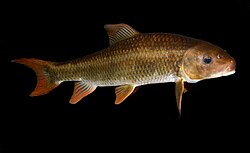| Moxostoma | |
|---|---|
 | |
| Robust redhorse (M. robustum) | |
| Scientific classification | |
| Domain: | Eukaryota |
| Kingdom: | Animalia |
| Phylum: | Chordata |
| Class: | Actinopterygii |
| Order: | Cypriniformes |
| Suborder: | Catostomoidei |
| Family: | Catostomidae |
| Subfamily: | Catostominae |
| Genus: | Moxostoma Rafinesque, 1820 [1] |
| Type species | |
| Catostomus anisurus Rafinesque 1820 [1] | |
| Species | |
23, see text. | |
| Synonyms [1] | |
| |
Moxostoma, the redhorses or jumprocks, is a genus of North American ray-finned fish in the family Catostomidae. Redhorses are variable in size, geographic location, and other ecological traits such as spawning substrate. [2] [3] [4] Several redhorses are long-lived (lifespans greater than 20 years), much like many other catostomid species. The silver redhorse is the longest-lived redhorse known by nearly a decade, with ages exceeding 40 years. [2] Redhorses are broadly of conservation concern, as these long-lived species are highly intolerant to environmental pollution, [5] habitat fragmentation, [5] and are currently subject to unregulated 21st century sport bowfishing which is removing and wantonly wasting several of these species by the ton. [2]